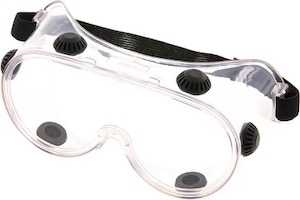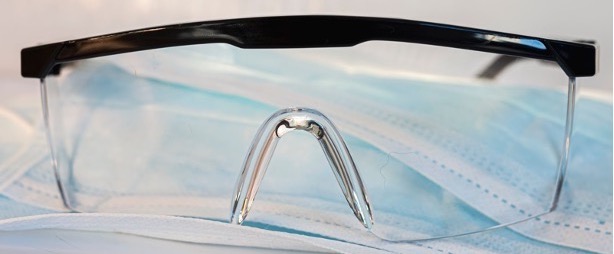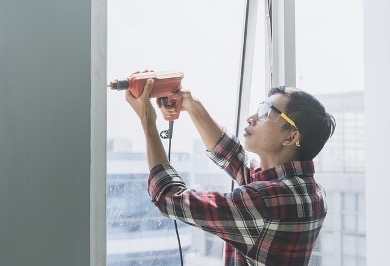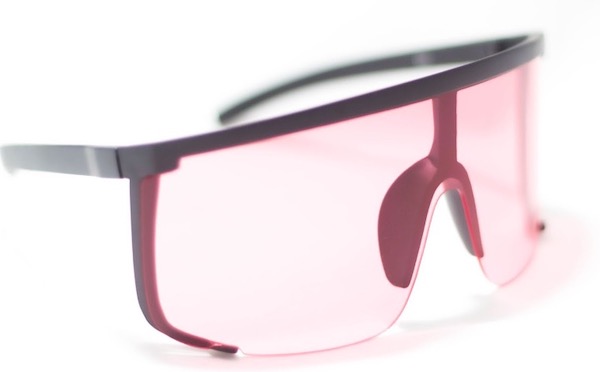Safety Glasses and Goggles Overview

Figure 1: Safety goggles
Whether actively engaged in sports, cleaning the house, or working in a factory, eye injuries can happen anywhere. They can result from exposure to chemicals in your work environment and are pretty prevalent, as there are reportedly 2.4 million eye injuries annually. These symptoms range from a black eye that goes away after a few days to irritation, corneal abrasion, and even bleeding. Wearing safety glasses or goggles is the best way to protect your eyes. In this guide we cover what safety glasses are, how they're different from safety goggles, and how to choose between available options.
Table of contents
- Why eye protection is important
- Safety glasses overview
- Safety goggles overview
- How to choose between safety glasses and goggles
- Safety glasses vs goggles
- Additional considerations when selecting safety glasses and goggles
- FAQs
View our online selection of safety goggles and safety hoods!
Why eye protection is important
Whether you're in construction, work in a factory with chemicals, or engage in DIY using materials that could potentially turn into projectiles, eye protection is of the essence. Our eyes are often the most exposed part of our face and hence the most vulnerable to injury. Simply wearing safety glasses prevents up to 90% of annual eye injuries. Eye injuries result from:
- Chemicals such as sulfuric acids, lye, ammonia, and aerosol
- The impact from blunt objects such as tools, wood, or metal
- Scratches from materials during DIY projects
Safety glasses overview
Though often used interchangeably, safety goggles and glasses are not the same. Safety glasses (Figure 2) typically feature a more lifestyle look thanks to the adjustable side arms worn over the ears like regular glasses. However, they're more durable and feature lenses and frames made from durable materials such as polycarbonate. Also, safety glasses often feature side shields to protect the eye from the sides. Safety glasses are mainly designed to offer impact protection, and the best are usually durable enough to resist impact from a ½ steel ball thrown at a speed of 150fps.
Nonetheless, they have small gaps around the frame and wouldn't be ideal for airborne or splash hazards applications. Generally, safety glasses are an excellent eye protection option because they are often lightweight and boast a conventional sunglass design making them easy to wear and generally comfortable. They also offer outstanding impact protection and come in an array of configurations. Common types include:
- Polarized safety glasses: these often feature lenses embedded with a polarized or laminated film filter to block intense reflected light. As a result, they eliminate glare and improve the user's vision, making them ideal for highly-lit applications such as electrician-related tasks.
- Prescription safety glasses: these are manufactured with a prescription lens. Prescription safety glasses are specially designed for individuals with already existing visual concerns and are often tailored to specifications set by their professional eye care expert.
- Construction safety glasses: this style offers optimum impact protection from the many hazards construction workers are exposed to at work.
- Fog-proof safety glasses: also known as anti-fog glasses, these are often ANSI-approved and feature lenses that remain fog-free for about eight seconds even when worn in humid conditions.

Figure 2: Safety glasses
Safety glasses concerns
Even though they're durable, comfortable, and offer excellent impact protection, safety glasses generally lack top shields. In addition, they are not form-fitting, which leaves the eyes exposed to spills, airborne pathogens, and even projectiles. However, this isn't much of a deal-breaker since they're effective at their job when you only need impact protection.
Safety goggles overview
Like safety glasses, goggles are also made from durable materials, but instead of sidearms, they often feature an adjustable rubber strap the user wears around the head. Thanks to this, and their sizable eye-cup lens design, safety goggles are form-fitting and completely protect from air pathogens and splash hazards. But they're not all the same. Common types include:
- Direct vent safety goggles: these often feature small holes or perforations along the top or sides of the frame to facilitate smooth airflow while the user is working and prevent fogging, which is common with safety goggles.
- Indirect vent: these goggles are also vented, but the perforations are often angled away from the front lens to ensure smooth airflow while preventing contamination from splash and dust or other airborne particles. The design also prevents fogging.
- Closed goggles: these have no venting whatsoever and offer the best protection from everything, including impact, splash, and airborne hazards. However, they fog up fast and are best in applications where you wouldn't have to wear them for long.
Safety goggles concerns
Due to their design, safety goggles often create an airtight fit around the eyes, offering complete protection from projectiles, splashes, and anything airborne. One can also wear them over corrective lenses. However, they are often large and can feel bulky, especially for first-time wearers. They also fog up quickly, especially those with a closed vent design.
Safety glasses vs goggles
Critical differences include:
- Design: safety glasses feature a standard sunglass design with adjustable arms, while safety goggles spot an elastic rubber strap that you wear around the head.
- Function: safety glasses are essential for impact protection, while safety goggles offer more comprehensive eye protection from impact, airborne pathogens, and splash hazards.
- Side shield: glasses feature a side shield, while goggles are often large and feature a cup-like design with vents around the eye area.
How to choose between safety glasses and goggles
Wondering when to choose safety goggles over glasses? Check out a few factors you should consider to make the right decision:
ANSI Z97.1 and OSHA 1910.33 standards
The American National Standards Institute (ANSI), alongside the Occupational Safety and Health Administration, are regulatory bodies that create standard PPE regulations and requirements. While both bodies focus on enhancing PPE safety, and OSHA requires that all safety glasses feature ANSI's approval, they have different impact resistance ratings for safety glasses vs. goggles. To choose between glasses and goggles, perform a hazard analysis on potential applications to determine which of the two gears offers the best impact protection rating for the task based on ANSI and OSHA standards. These are regulating standards for mainly the US and European countries. Check out your country's regulations when it comes to safety glasses and goggles.
Applications
The easiest way to choose between safety goggles and glasses is by considering the nature of your application and the common hazards it presents. For example, for applications that expose the user to smoke and poisonous gases, flying metal particles, chemical splashes, or electric flashes, choose safety goggles over glasses. Work environments with such conditions include:
- Medical laboratories
- Welding
- Automotive shops
- Factory assembly line jobs
For applications with no splash or airborne hazards and where comfort is of the essence, opt for safety glasses. Such applications often include plumbing, electricians, and construction. Always make sure that you wear appropriate PPE such as glasses and safety gloves when doing potentially dangerous jobs.

Figure 3: Use safety glasses during DIY projects
Additional considerations when selecting safety glasses and goggles
Other important factors to prioritize when choosing between safety glasses and goggles include:
Durability
Both safety glasses and goggles are an investment, and the last thing you want is a pair that breaks after a week or worse, breaks on impact while you're wearing them. So, ensure you consider the durability of the material used. Usually, most quality protective goggles and glasses feature lens made from polycarbonate, a lightweight material known for excellent UV and impact-resistant material. Other great material alternatives include NXT & Trivex, glass, and acrylic. These materials are durable enough to withstand impact, and even if they do break, they don't often shard, meaning they won't pose an eye safety hazard even if they break when wearing them.
Lens coatings and tints
Lens coatings refer to treatments added to safety glass and goggles lenses to boost their functionality and appearance. The most common include UV-protection coatings meant to make the safety glasses or goggles UV-resistant and anti-fog coatings often used in fog-proof safety glasses. Tints, on the other hand, reduce light intensity. They range from simple colored coatings that protect the user from bright light to specially-tinted lenses that protect from specific hazards such as weld flashes from welding applications.

Figure 4: Coated safety glasses
Comfort
The safety glasses or goggles you opt for may be of superior quality. Still, if you're not comfortable wearing them, you'll probably ditch and work without them, exposing yourself to hazards. Instead, look for protective goggles or lightweight cutting torch glasses with adjustable sidearms or elastic rubber to ensure a comfortable fit. Also, always prioritize fog-proof safety glasses or vented protective goggles.
FAQs
How can you tell if safety glasses or goggles are safely rated?
All safety–approved glasses and goggles will often feature an ANSI Z87.2 stamp of approval on the side arms or around the side shield.
When is it safe to use safety glasses over goggles?
Even though most people choose safety goggles over glasses, it'd be wiser to use glasses in applications where the risk of direct impact is high, and there are no airborne, splash, or flying hazards.
How do I disinfect safety glasses or goggles?
Immediately after leaving the job site, soak a microfiber cloth in a disinfectant solution and wipe the glasses or goggles entirely. Let them dry for about ten minutes, and then using a lens cleaner and another microfiber cloth, wipe the lenses clean.





